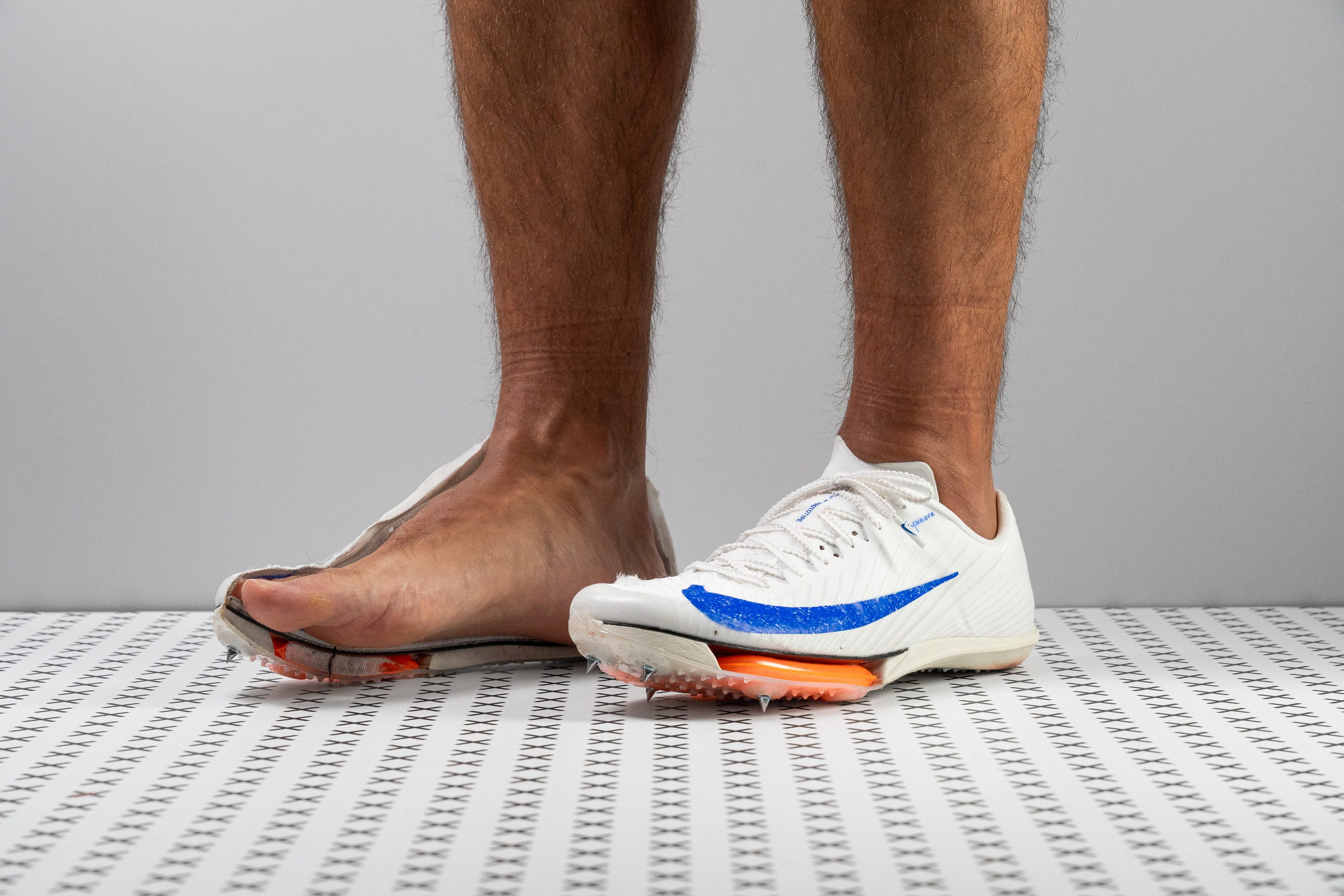Our verdict
- Top pick in best track spikes
- Top pick in best sprints track spikes
Pros
- Explosive ride
- Improved heel stability
- Enhanced midfoot design
- Dual Air Zoom units
- Premium materials
- Excels at anything below 800m
- Ready for hurdles too
- Stiff carbon plate
Cons
- Still not durable
- Heavier than previous version
- Steep price tag
Audience verdict
- Top 29% in sprints track spikes
- Top 8% most popular tracking shoes
Comparison
The most similar track spikes compared
+ + Add a shoe | |||||
|---|---|---|---|---|---|
| Audience score | 94 Great! | 90 Great! | 90 Great! | 93 Great! | |
| Price | $190 | $180 | $150 | $180 | |
| Weight lab | 6.4 oz / 181g | 6 oz / 169g | 5.5 oz / 156g | 6.5 oz / 183g | |
| Breathability | Moderate | Moderate | Breathable | Breathable | |
| Use | Sprints | HurdlesSprints | HurdlesSprints | HurdlesSprints | |
| Removable spikes | ✓ | ✓ | ✓ | ✓ | |
| Width / fit | Medium | Narrow | Medium | Medium | |
| Toebox width | Medium | Medium | Medium | Narrow | |
| Drop lab | -2.0 mm | -0.9 mm | 0.0 mm | -5.8 mm | |
| Size | True to size | Slightly small | Slightly small | True to size | |
| Midsole softness | Balanced | Balanced | - | Balanced | |
| Tongue padding | Thick | Thick | Average | Thick | |
| Stiffness | Stiff | Stiff | Moderate | Stiff | |
| Torsional rigidity | Stiff | Stiff | Moderate | Stiff | |
| Heel counter stiffness | Moderate | Moderate | Flexible | Flexible | |
| Outsole thickness | Thin | Average | Very thick | Average | |
| Heel tab | None | None | Finger loop | None | |
| Heel stack lab | 15.7 mm | 15.9 mm | 12.3 mm | 11.0 mm | |
| Forefoot | 17.7 mm | 16.8 mm | 12.3 mm | 16.8 mm | |
| Insole thickness | Average | Average | Average | Average | |
| Midsole width - forefoot | Average | Average | Very narrow | Very wide | |
| Midsole width - heel | Wide | Average | Very narrow | Average | |
| Ranking | #4 Top 31% | #9 Bottom 30% | #7 Bottom 46% | #5 Top 39% | |
| Popularity | #1 Top 8% | #6 Top 47% | #4 Top 31% | #11 Bottom 15% |
Who should buy
We believe the Maxfly 2 is a solid pick for:
- Elite sprinters chasing personal bests.
- Track enthusiasts seeking a powerful, propulsive ride—without worrying about the high price tag!
- Fans of the original Maxfly who thrived with its explosive Air Zoom units and need a new pair. It's time to upgrade!
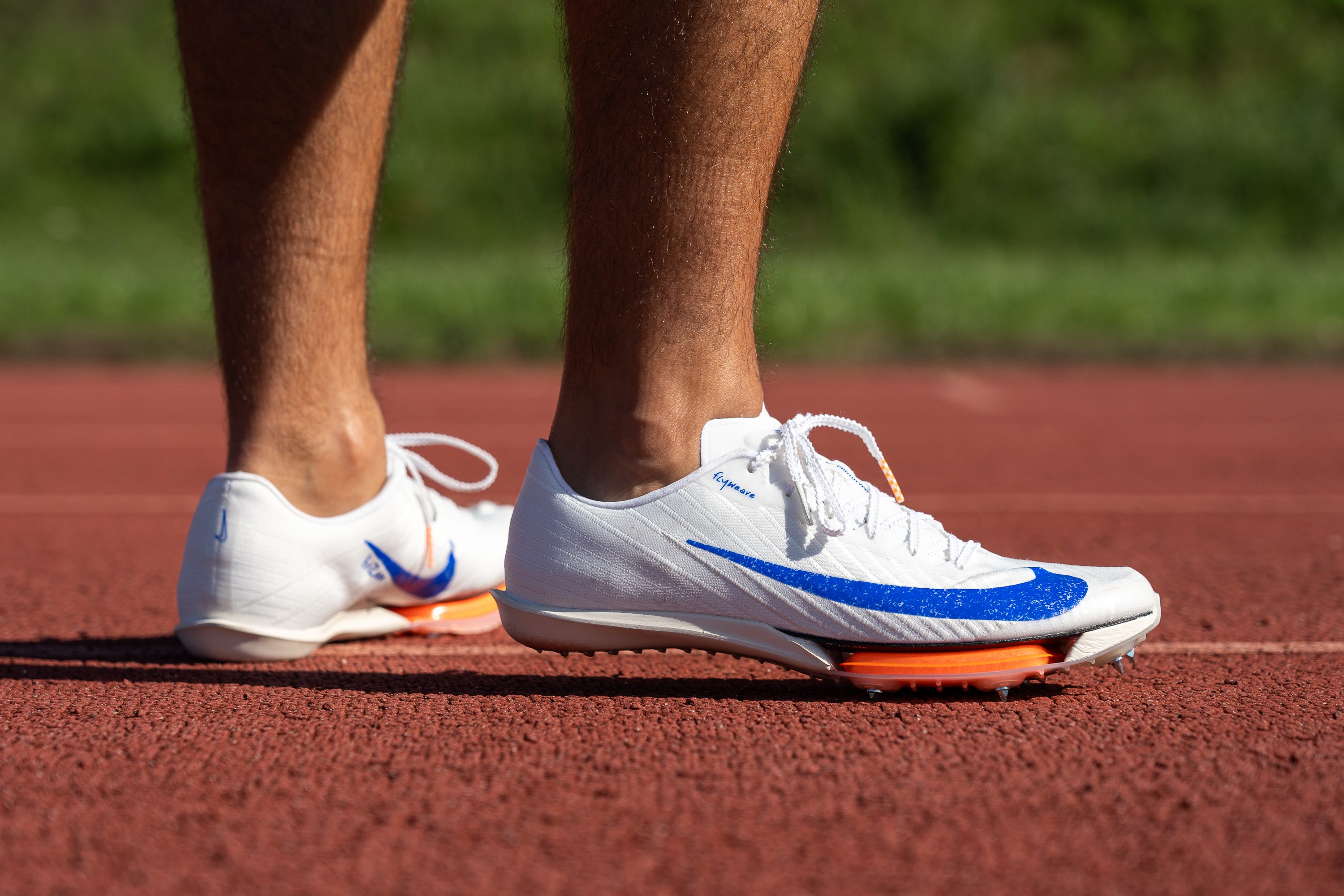
Who should NOT buy
We are pretty sure that the Maxfly 2 isn't the best option for beginners, as it demands exceptional technique and significant power to fully unlock its performance potential. In our experience, its steep price also makes it less appealing for those just starting on the track. And we proved here in the lab that the Nike Zoom Superfly Elite 2 is a more affordable and beginner-friendly choice.
We also found that the Maxfly 2's durability remains a weak point, just like the first version—especially for its price. If longevity is a priority for you, we recommend the Adidas Prime SP2, which excels in this regard.
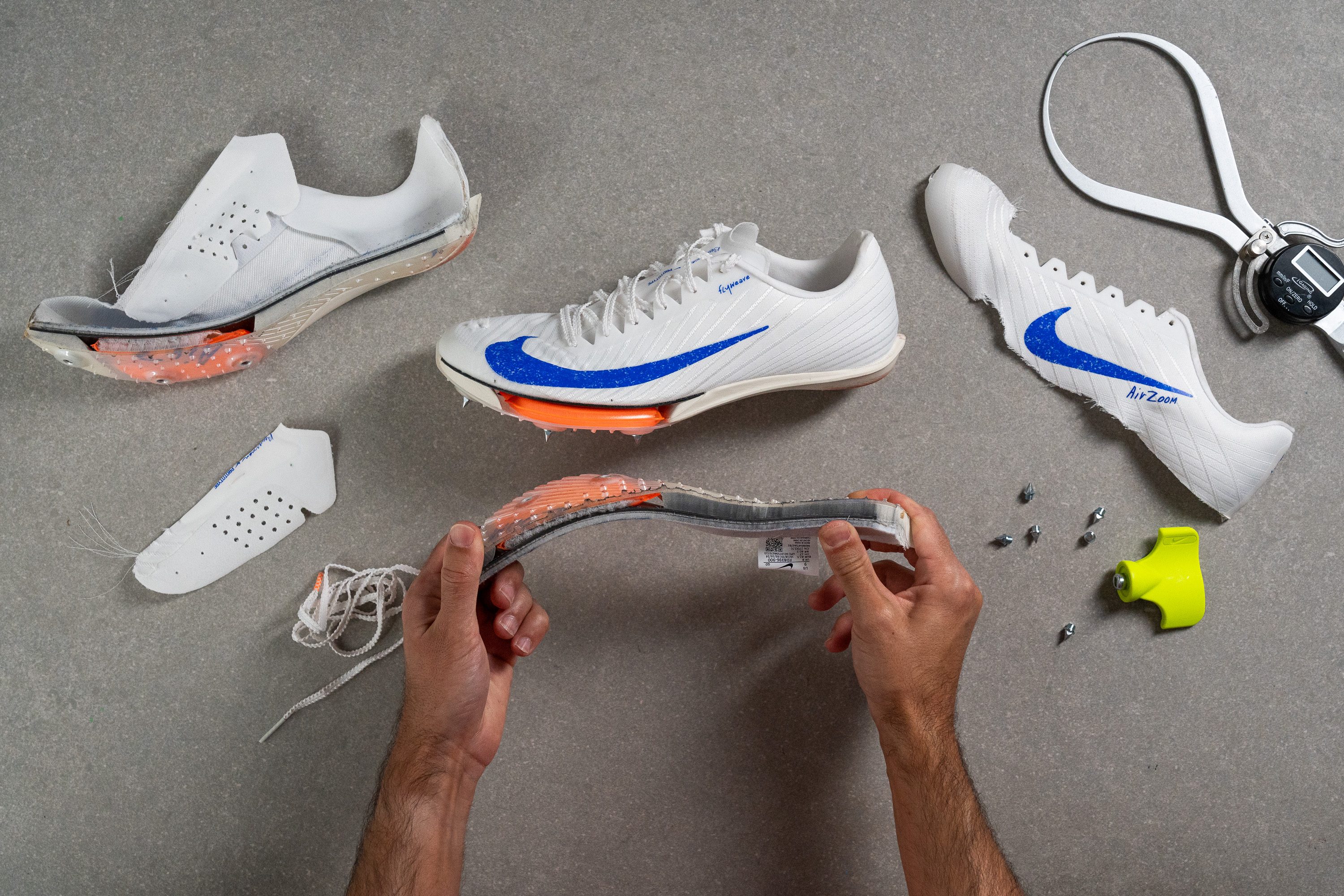
Cushioning
Heel stack
The heel measures 15.7 mm in stack height, which is more than most sprint spikes that typically stay closer to the ground.
We found this extra height particularly useful for athletes who occasionally lose form and strike farther back, especially during those lactic-acid-filled 400m or 800m races.
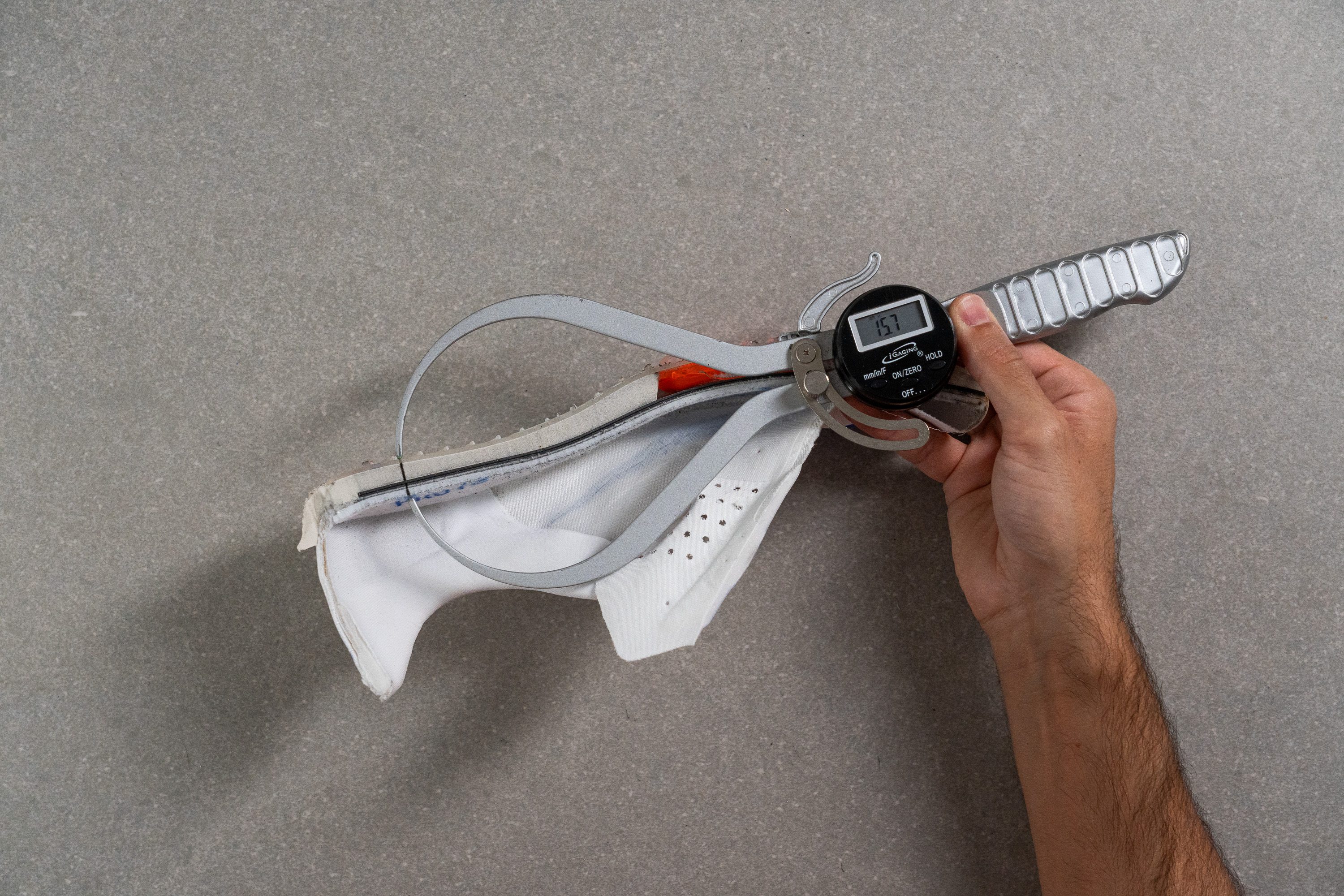
| Maxfly 2 | 15.7 mm |
| Average | 15.8 mm |
Forefoot stack
The forefoot measures 17.7 mm, just 2.3 mm under the 20-mm limit imposed by World Athletics after the Paris 2024 Olympics. By the way, there's almost zero foam here—it's made up entirely of the insole, plate, and Air Zoom units.
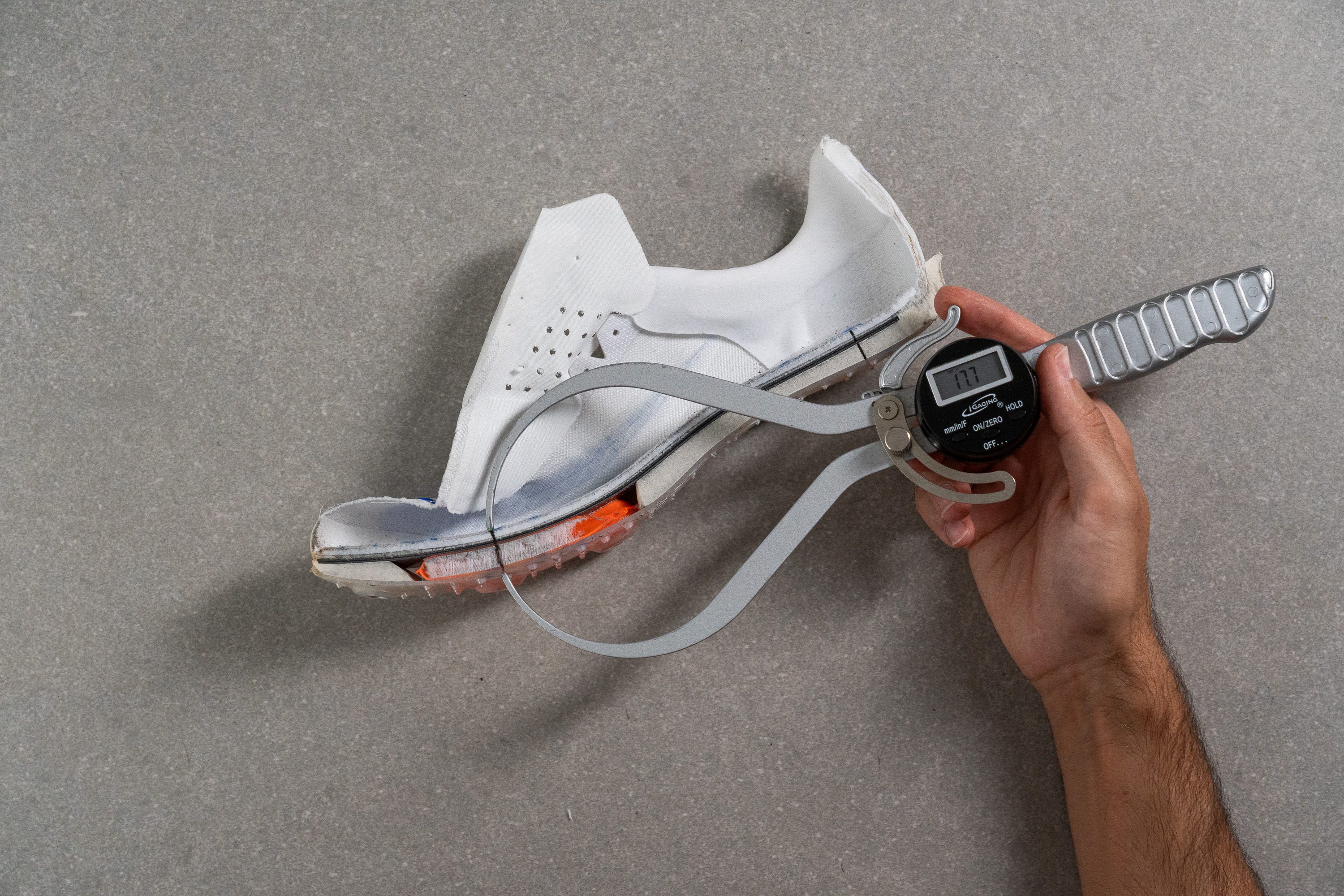
| Maxfly 2 | 17.7 mm |
| Average | 14.8 mm |
Drop
After these two measurements, we found the classic negative-drop design typical of elite sprint spikes, with a -2.0 mm difference.
This aggressive setup promotes powerful forefoot striking—we tested it and can confirm that it truly does!
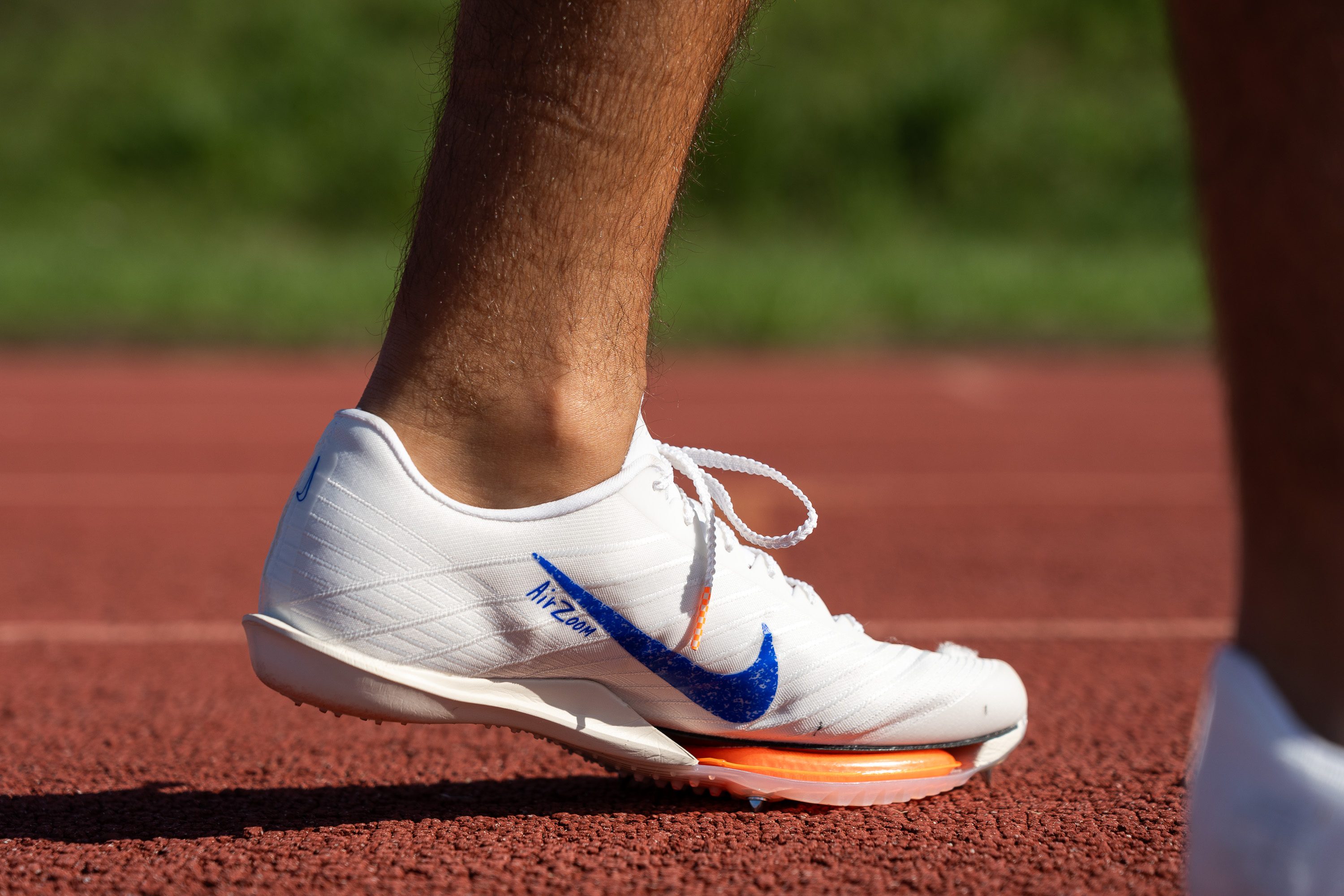
| Maxfly 2 | -2.0 mm |
| Average | 1.0 mm |
Midsole softness
As we mentioned earlier, there's no foam in the forefoot, but Nike has included its premium ZoomX foam in the heel—the same material found in models like the Vaporfly 3.
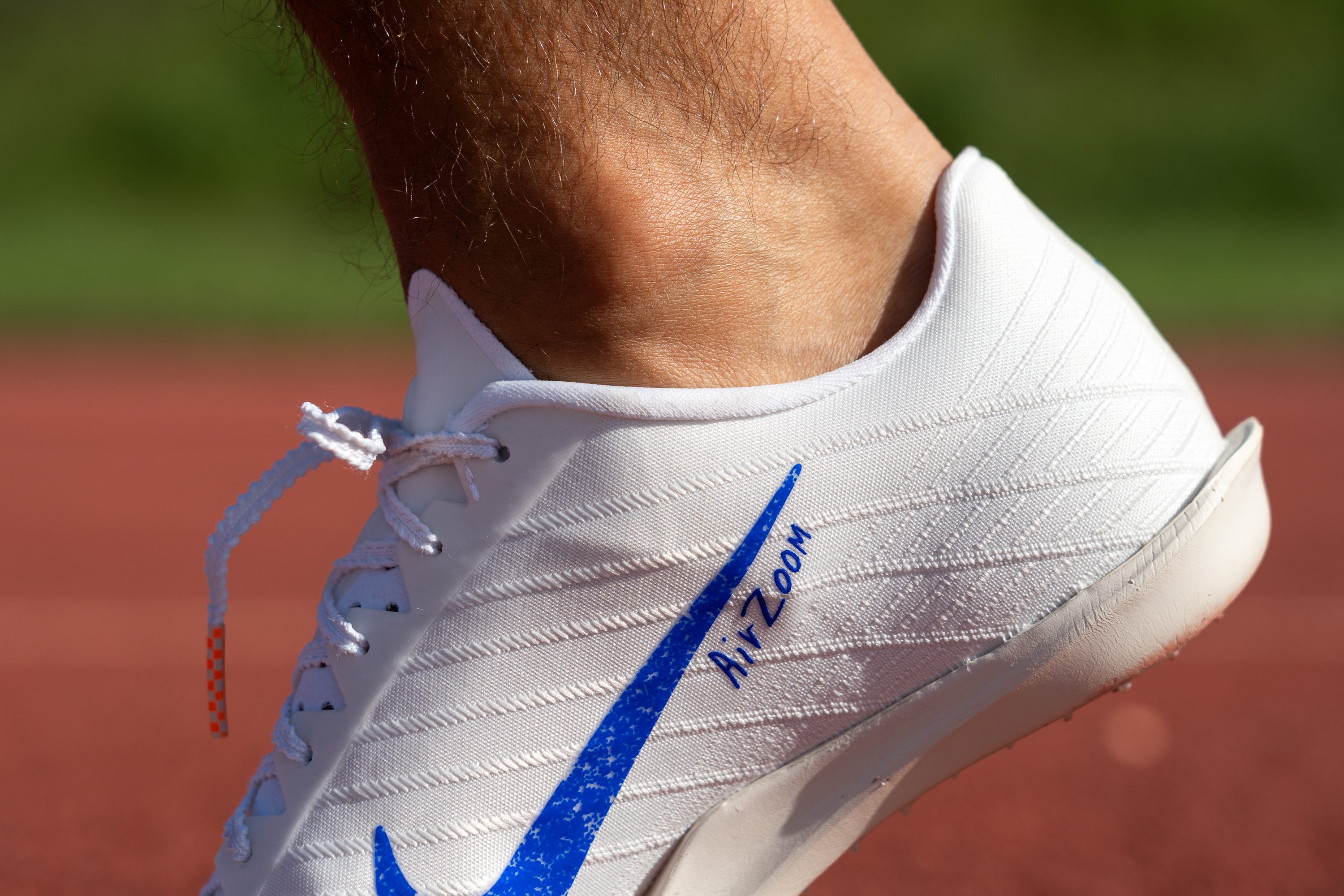
We tested this foam and found it firmer than other versions of ZoomX, scoring 23.3 HA in our Shore A durometer. This makes sense given the Maxfly’s thin layer, designed to keep the shoe lightweight and close to the ground.
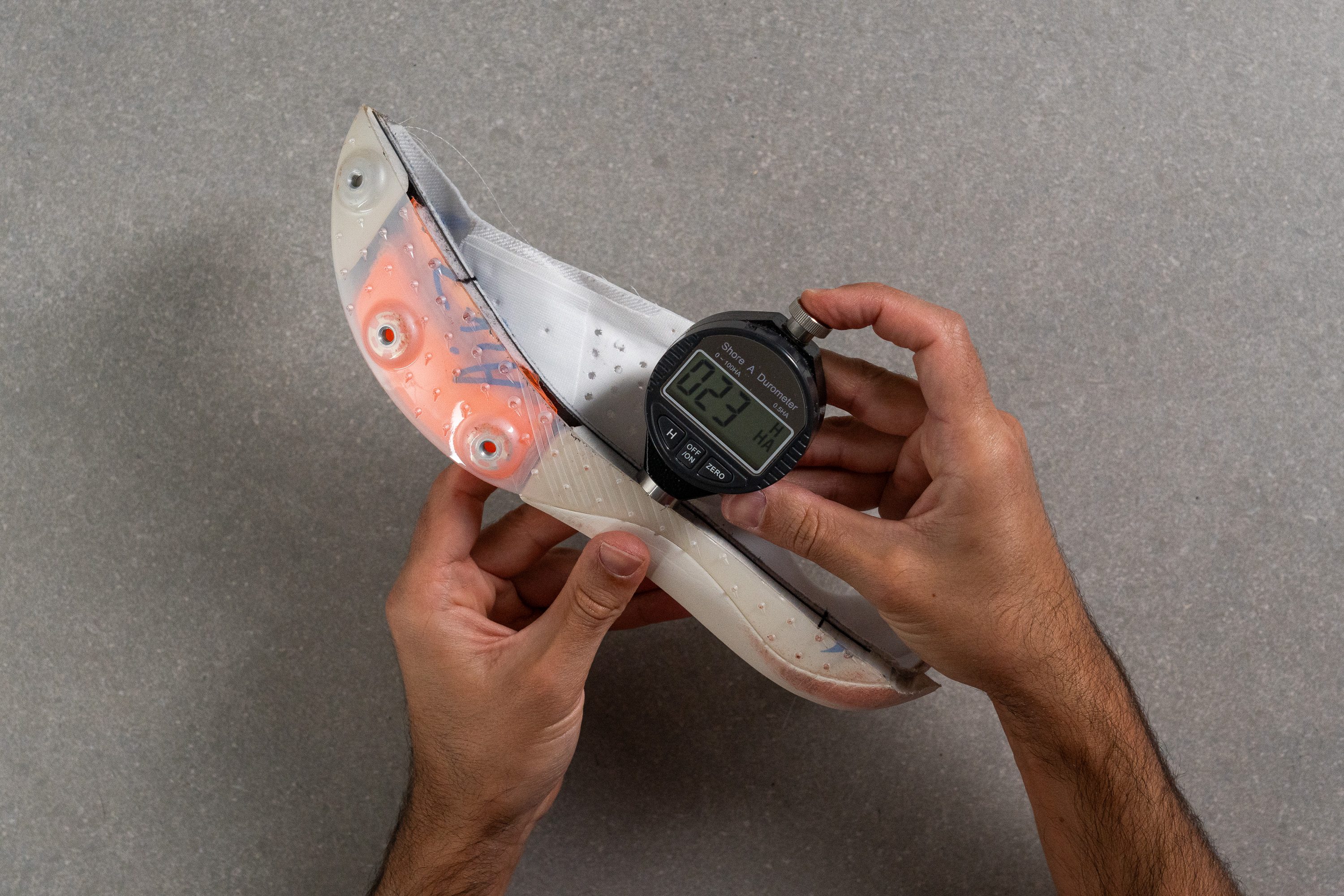
| Maxfly 2 | 23.3 HA |
| Average | 24.3 HA |
Air Zoom
Nike has made great use of its Air Zoom technology in the Maxfly series, featuring again a dual-chamber design in the forefoot that delivers explosive bounce with incredible energy return. In fact, we think that no foam on the market can match the rebound from this pair of Air Zoom units.
Plate
As with the Nike Alphafly 3, the Air Zoom units alone aren’t enough to maximize their potential. To fully harness their explosive energy, a carbon-fiber plate is essential. Nike has integrated its Flyplate technology from road racers, ensuring both Air Zoom units are fully compressed to give back as much energy as possible.
And as we've discussed in our guide about foams, the foam isn’t sufficient on its own—a stiffening agent is key to unlocking the best possible energy return.
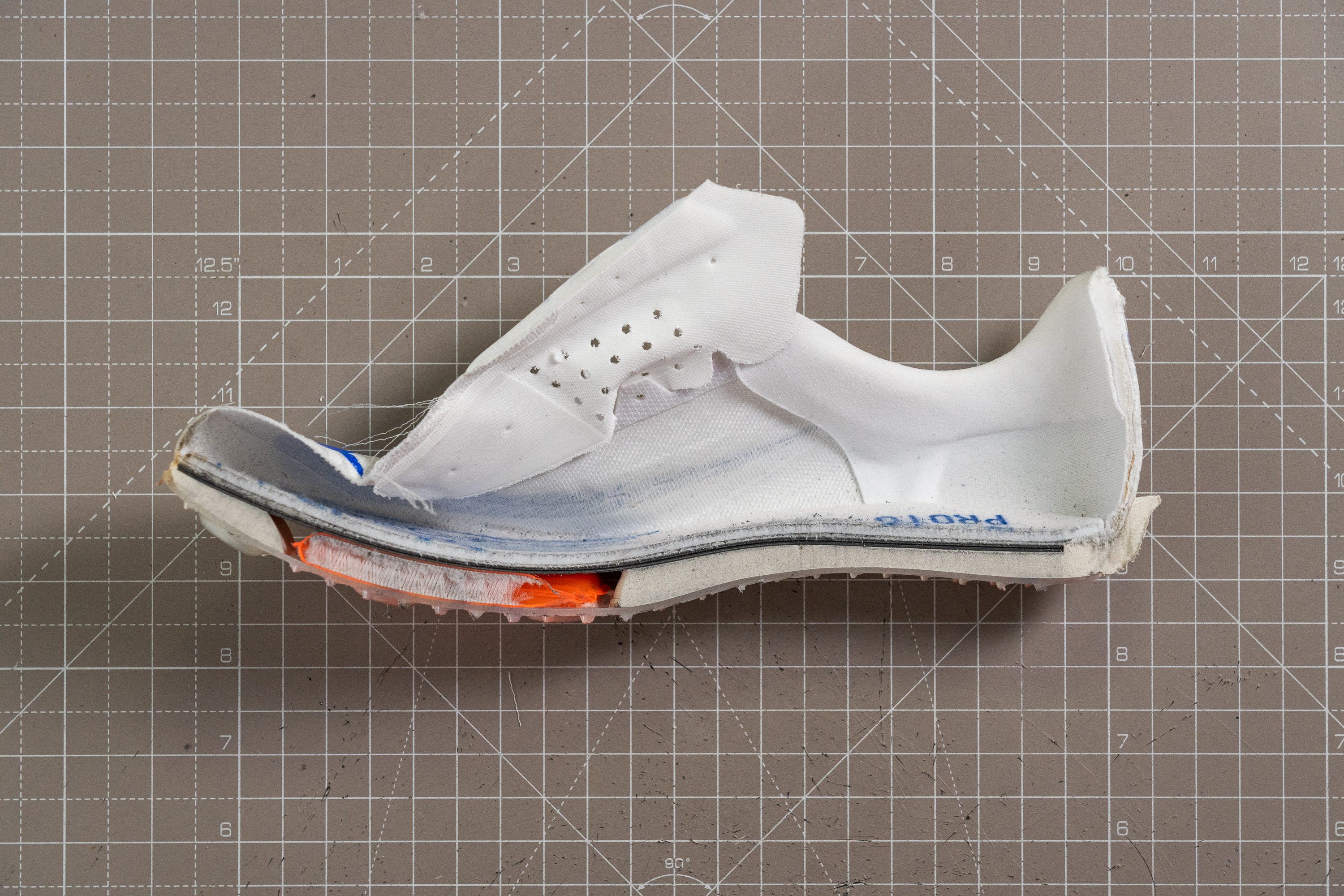
Size and fit
Size
Nike Maxfly 2 fits true to size (89 votes).
Width / Fit
Having poured a gel mold of the shoe's interiors, we found that Nike kept the fit almost identical to Maxfly's previous model. It’s still a snug, secure fit—ideal for short-distance racing and providing a locked-in feel.
Our caliper returned a standard reading of 86.4 mm in the widest part of the mold (between the pinkie and the big toe).
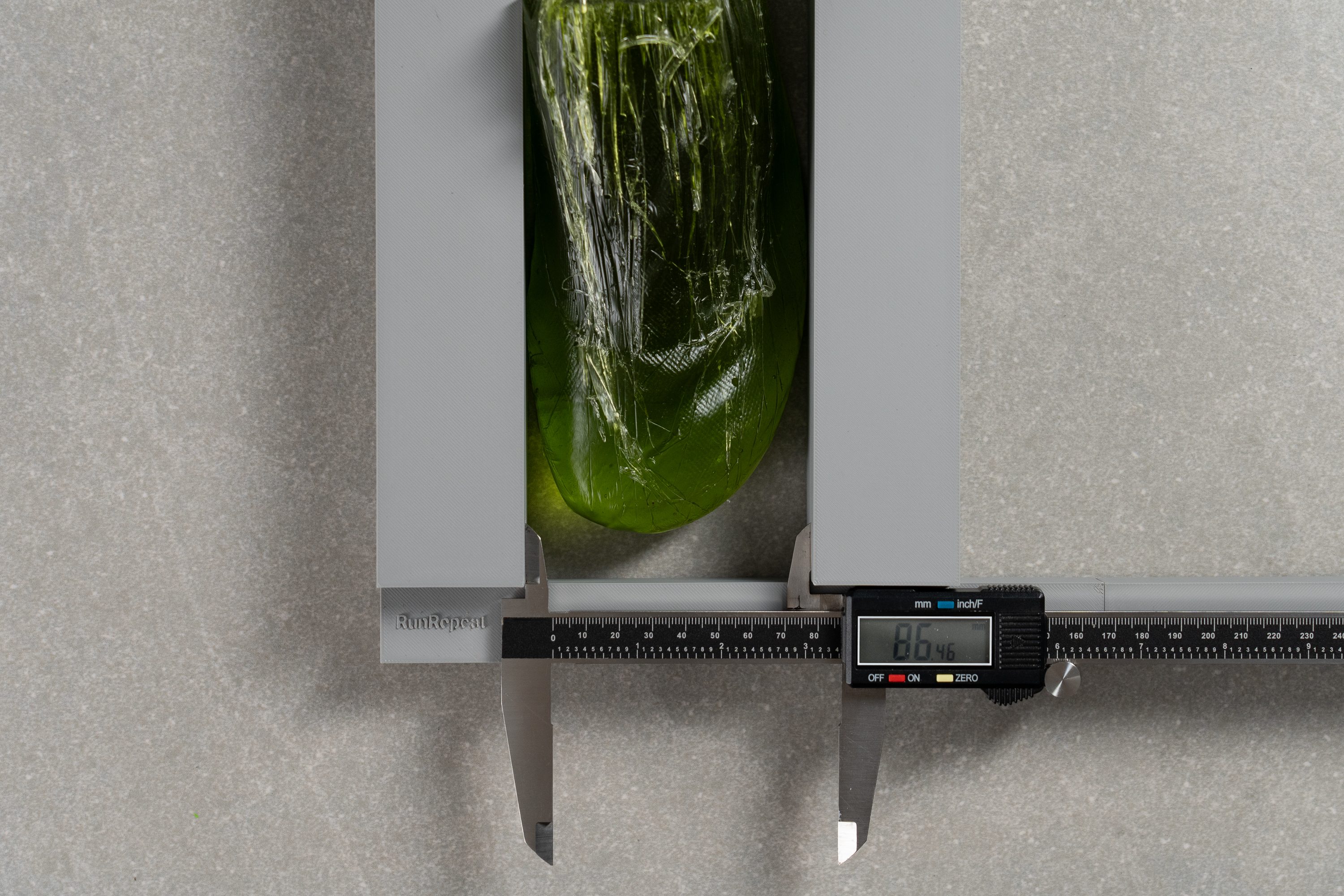
| Maxfly 2 | 86.4 mm |
| Average | 88.2 mm |
Toebox width
We took a second measurement in the big toe area and recorded 70.7 mm, which is impressively wide for a sprint spike. This makes it an excellent choice for those with square-shaped feet who often struggle with narrow models.
Interestingly, Nike’s spike design almost mimics the broader, anatomical shape of Altra running shoes, but when it comes to their road models, they revert to the more classic pointy toebox design. We found this contrast really funny!
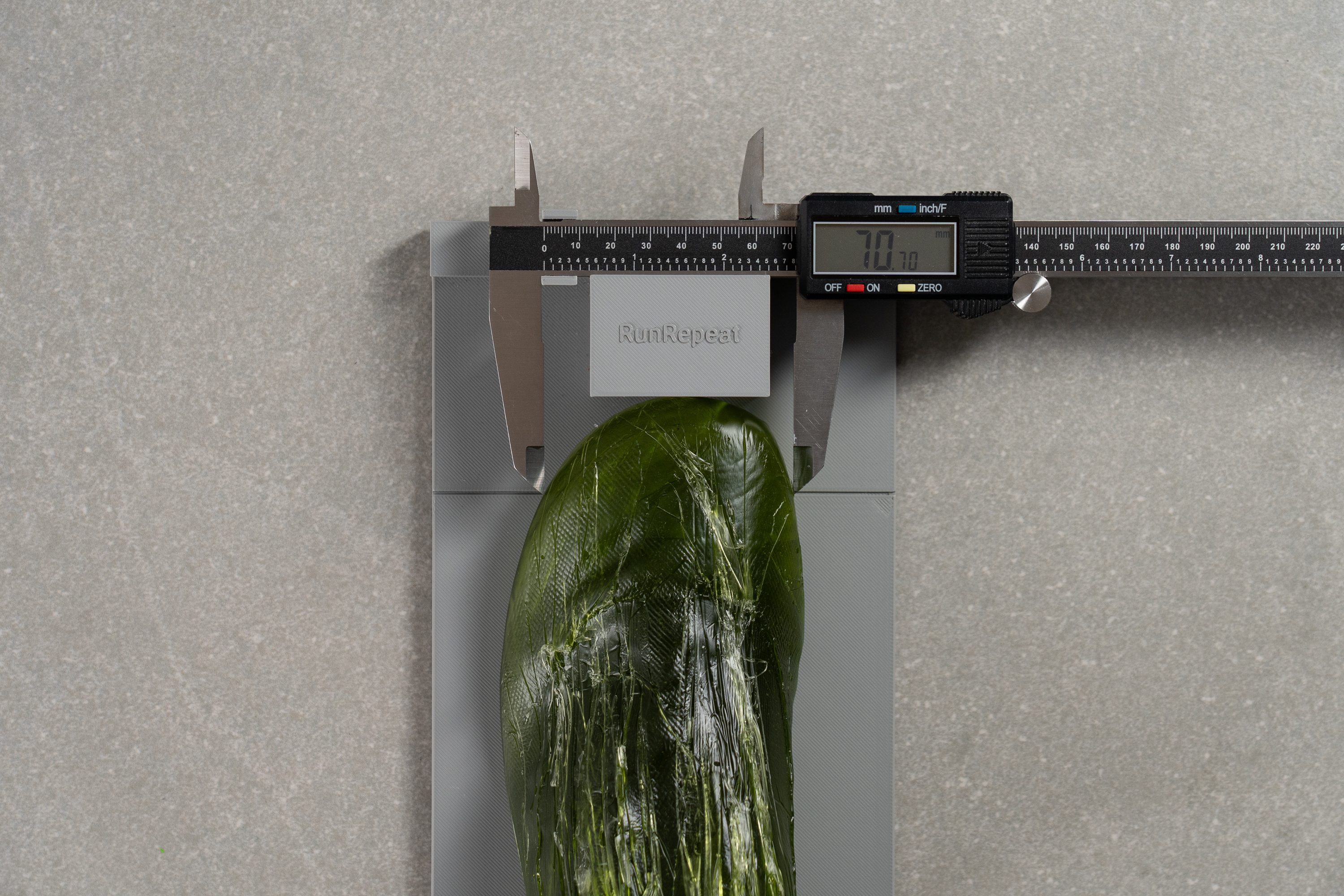
| Maxfly 2 | 70.7 mm |
| Average | 68.8 mm |
Toebox height
What we found more comfortable is the toebox height and midfoot, thanks to a slightly refined design.
For those who experienced discomfort in this region with the original version, we believe this tweak alone could justify the minor weight increase. Our caliper returned a decent toebox height of 23.9 mm.
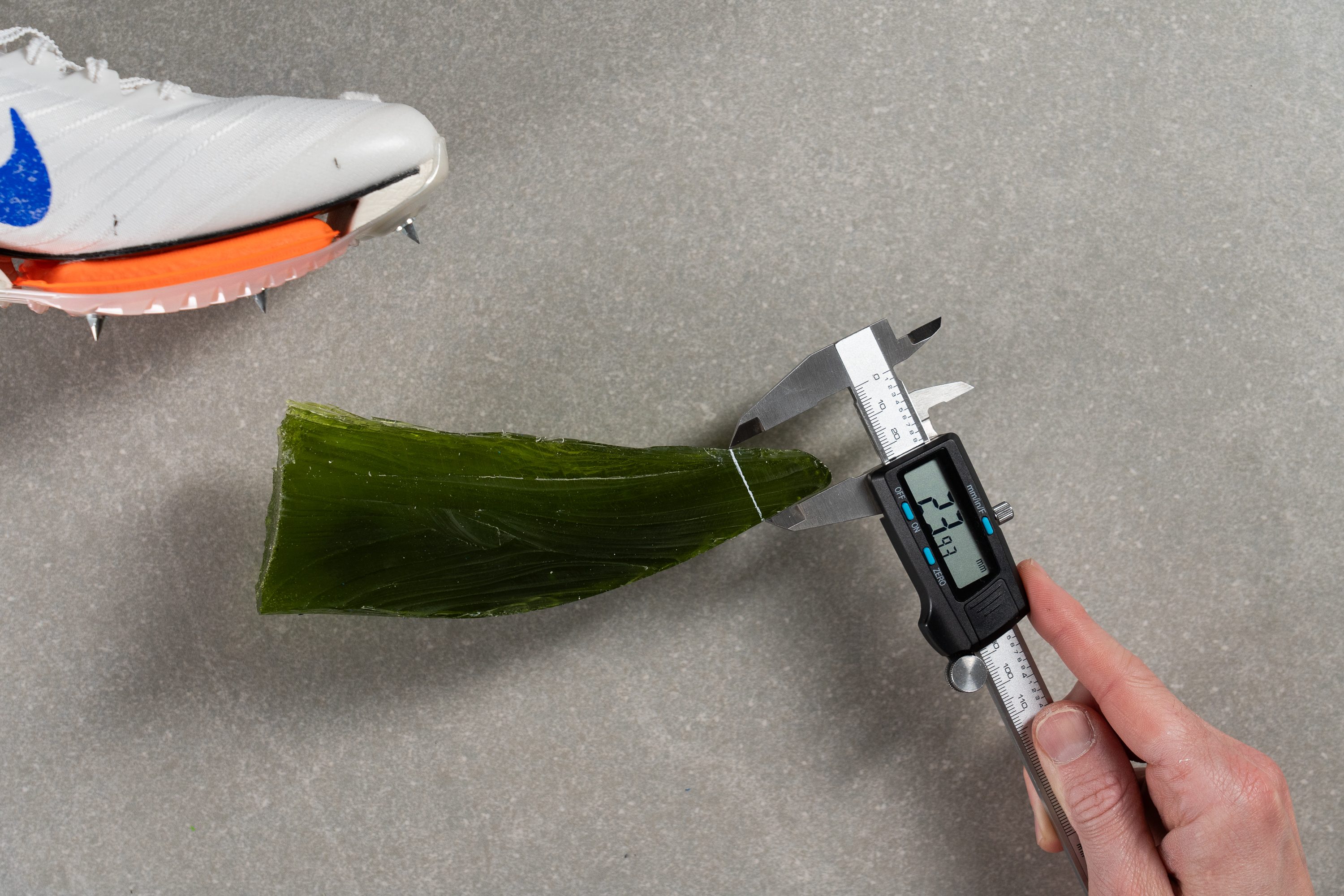
| Maxfly 2 | 23.9 mm |
| Average | 26.1 mm |
Flexibility / Stiffness
Did we say "stiffening agent"? Well, stiff it certainly is.
With a 22.5N result in our 30-degree bend test, get ready for a serious ride for your calves and tendons—this Maxfly 2 is tough to bend. And that’s exactly what you want in a carbon-plated, high-performance sprint spike.

| Maxfly 2 | 22.5N |
| Average | 13.0N |
Weight
One of the disappointments with this update is the increase in weight. The Maxfly 2 now weighs 6.4 oz or 181g, up from 6.0 oz or 169g in its predecessor.
Is this a dealbreaker? We don’t think so. In our view, differences of 5-10g between pairs are common due to manufacturing variations. Plus, a sub-1 oz increase is barely noticeable in terms of performance. But yeah, it’s still not ideal.
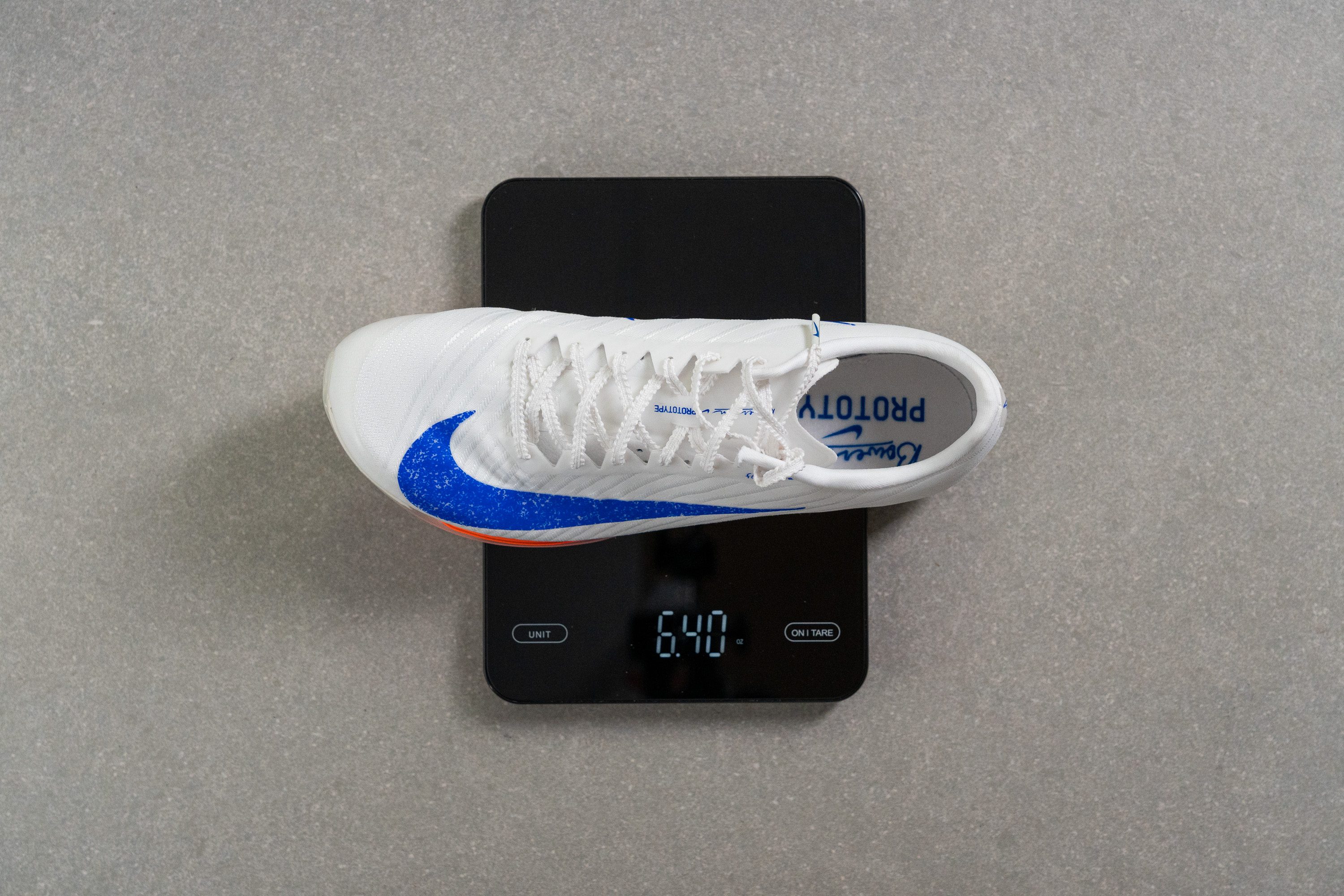
| Maxfly 2 | 6.4 oz (181g) |
| Average | 5.5 oz (156g) |
Breathability
Those looking for breathability improvements in the Maxfly 2 might be a bit let down. We found it performed below expectations, earning only a 3/5 in our smoke test—matching its predecessor. The difference in airflow is clear in the video below when compared against the mid-distance spike Nike Victory 2.
Using a light, we quickly understood why the ventilation falls short. Nike opted for a more structured, thicker upper to ensure a tight, race-ready fit, and we get it—when sprinting 100m or 200m, ventilation takes a back seat.
It wasn’t until we examined it under the microscope that we fully grasped the issue.
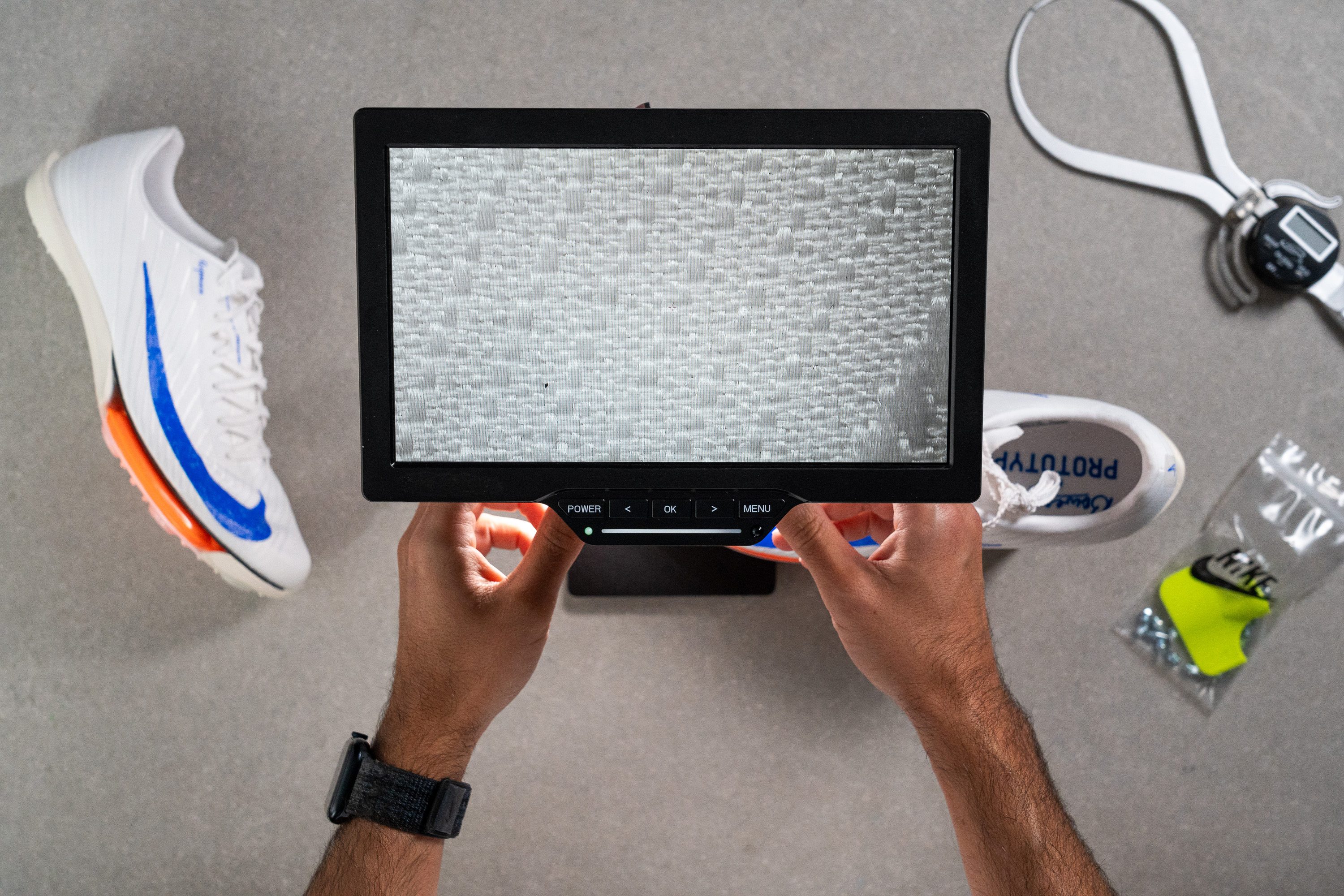
The Flyweave upper looks stunning in this white (Bowerman Prototype) colorway, but it has little space for air to escape. As simple as that.
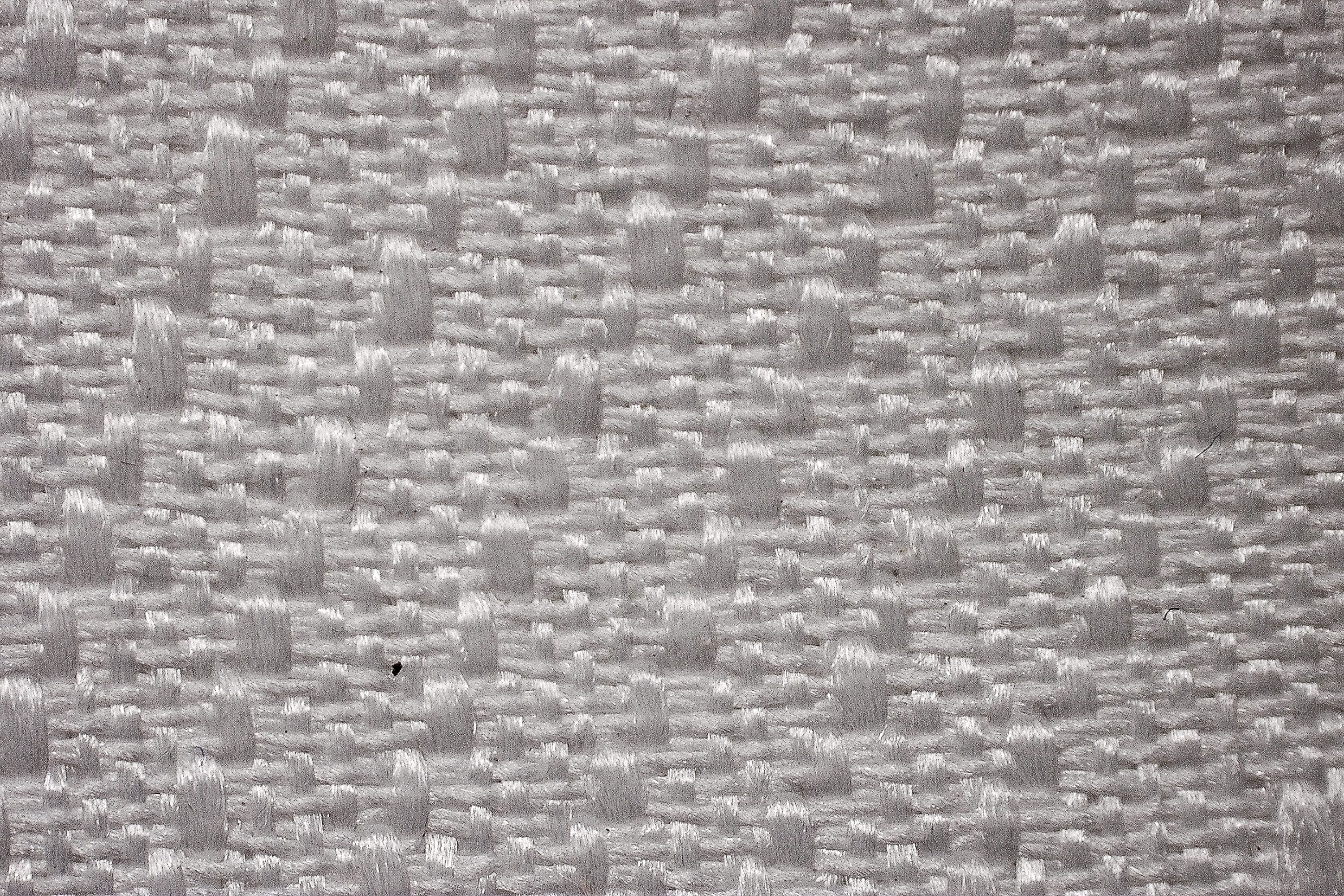
The upper does offer some stretch and solid padding through the heel. Overall, it’s a good design—just not the top choice for runners who prioritize breathability over other features.
| Maxfly 2 | 3 |
| Average | 4 |
Stability
Torsional rigidity
It’s not just stiff from a longitudinal perspective—torsionally, it’s just as firm. We tested it thoroughly and gave it a perfect 5/5 on our scale, the highest possible score.
In our tests, we found that this impressive stiffness ensures the Maxfly 2 maintains incredible stability.
| Maxfly 2 | 5 |
| Average | 3.2 |
Heel counter stiffness
The heel counter remains largely unchanged from the v1, holding a solid 3/5 score. While it’s uncommon for racing spikes to have this much structure, preventing even the slightest heel slippage is crucial in a sprint spike, and this stiffer design secures the heel.
| Maxfly 2 | 3 |
| Average | 1.6 |
Midsole width - forefoot
Now, let's dive into the midsole dimensions of the Maxfly 2. Nike kept the forefoot width at 93.5 mm, which, in our view, is just right.
Narrower wouldn’t offer stability, and wider would have made the Maxfly 2 unnecessarily heavy.
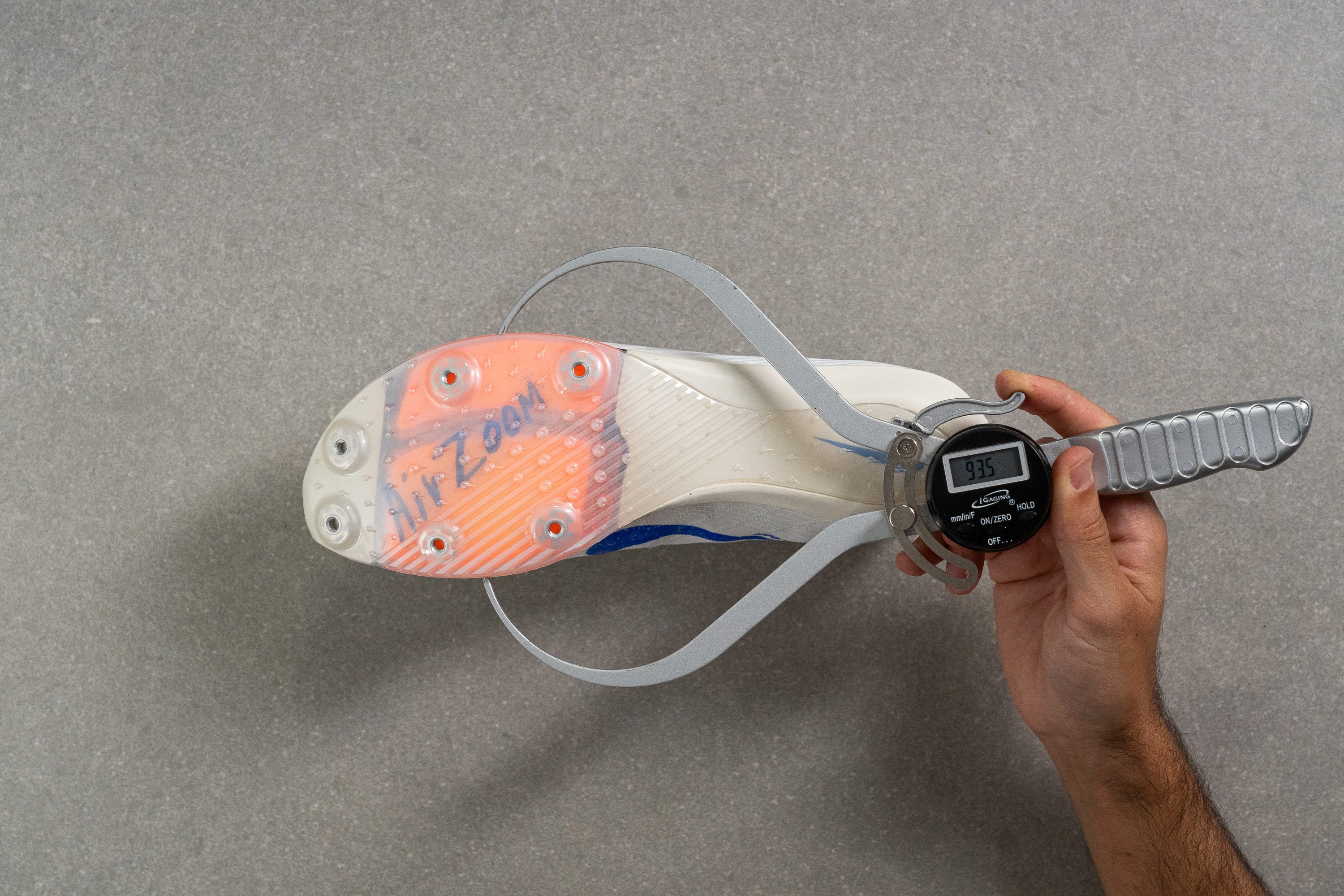
| Maxfly 2 | 93.5 mm |
| Average | 94.4 mm |
Midsole width - heel
The heel has been modified to be wider, and it’s definitely a positive change for many track warriors. One complaint from some sprinters was that those who don’t strike with full-forefoot technique found the OG Maxfly somewhat unstable.
The difference is clear, as it increases from 59.2 mm to 66.7 mm. Of course, this adds a bit of weight, but for many sprinters, this is a worthwhile trade-off.
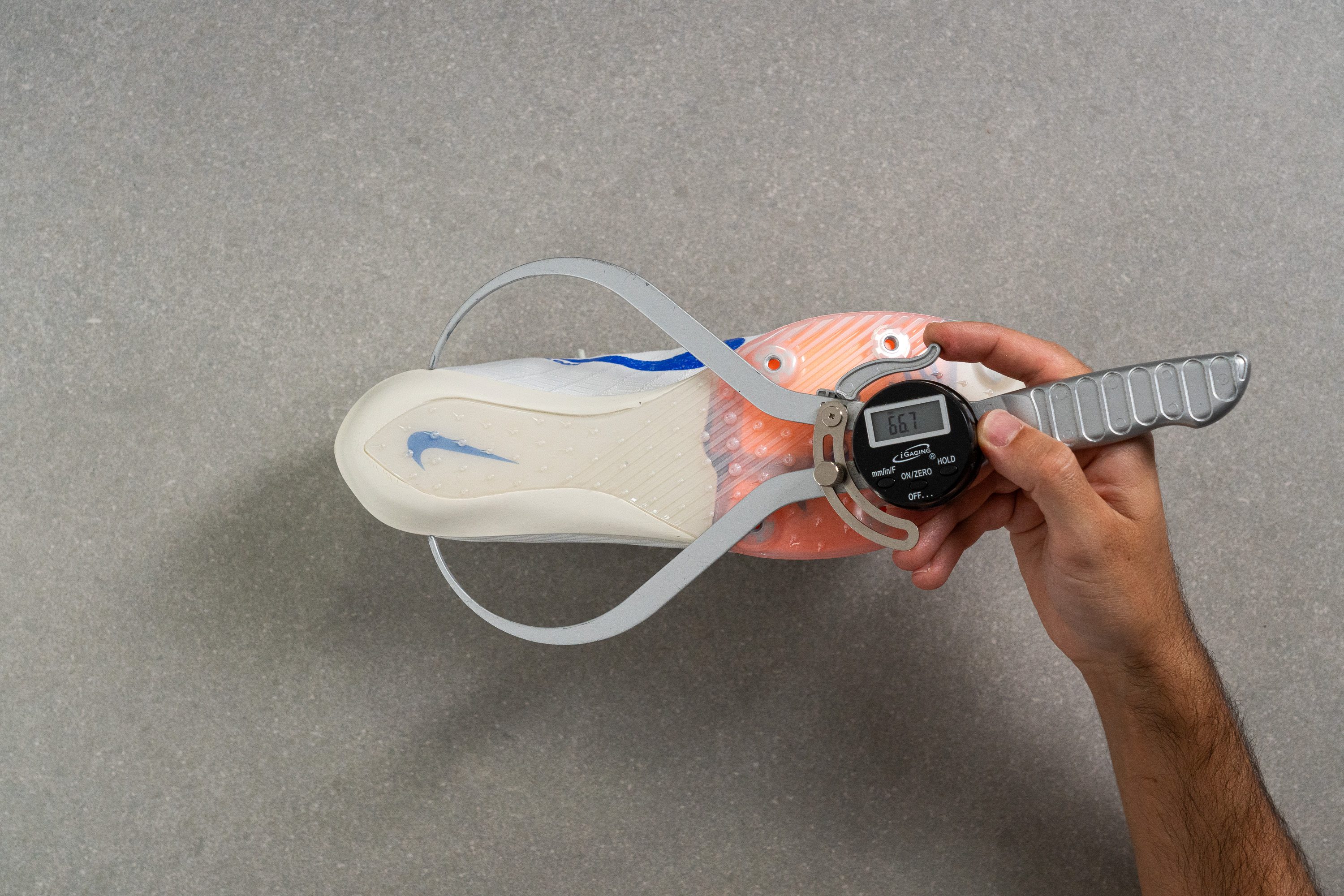
| Maxfly 2 | 66.7 mm |
| Average | 62.3 mm |
Durability
Toebox durability
The lack of ventilation holes didn’t translate into impressive durability at all.
In fact, it’s downright disappointing. After running our Dremel challenge, it scored a teeth-grinding 1/5. Our standpoint is that Nike seriously needs to step up here—if we’re not getting durability, at least give us some proper airflow.
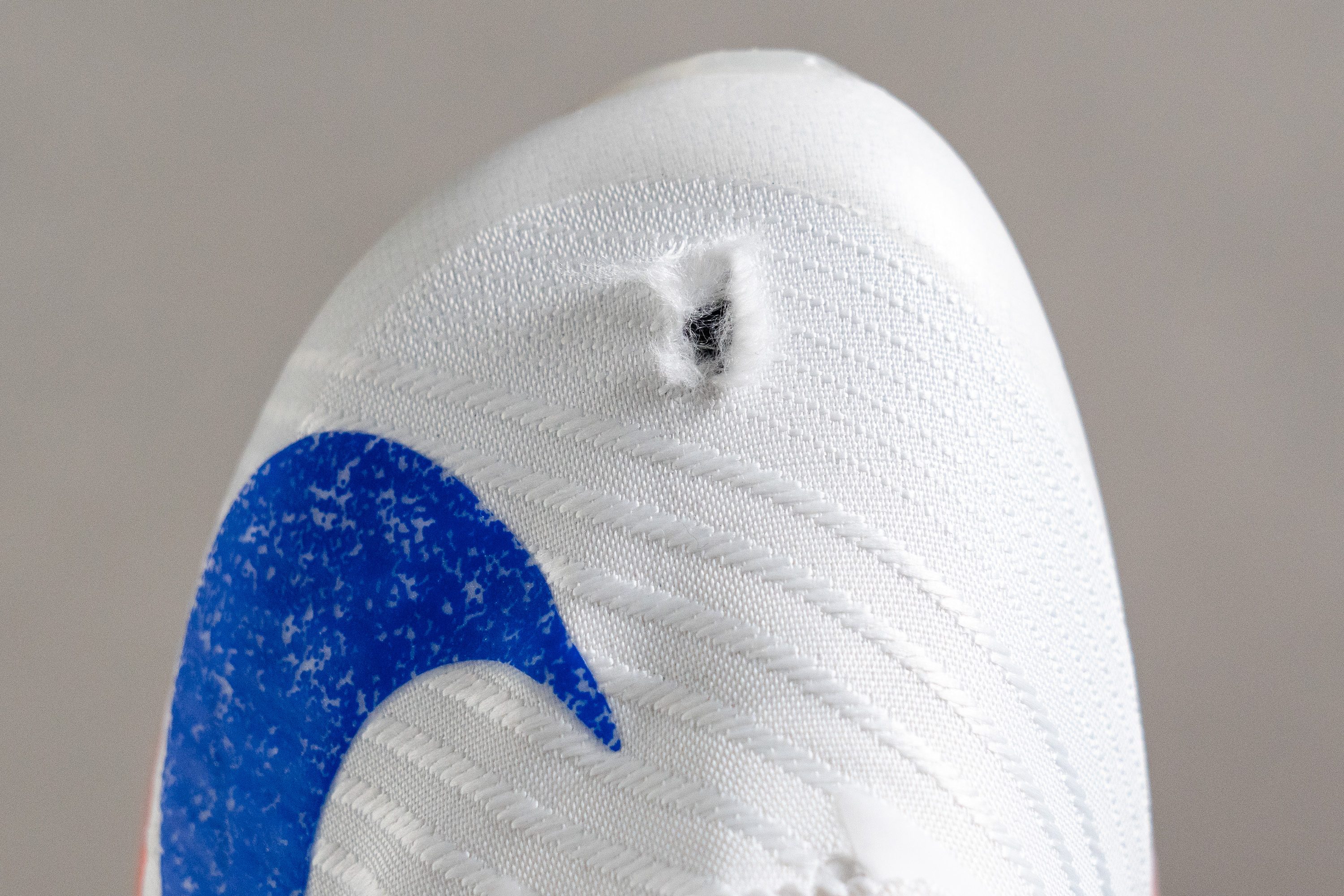
| Maxfly 2 | 1 |
| Average | 2.3 |
Heel padding durability
The heel padding slightly improved, but not by much—and honestly, we expected more.
After running our second Dremel test, we found it scored another disappointing 2/5. In our view, that’s still faaar from good, and we believe there’s room for serious improvement.
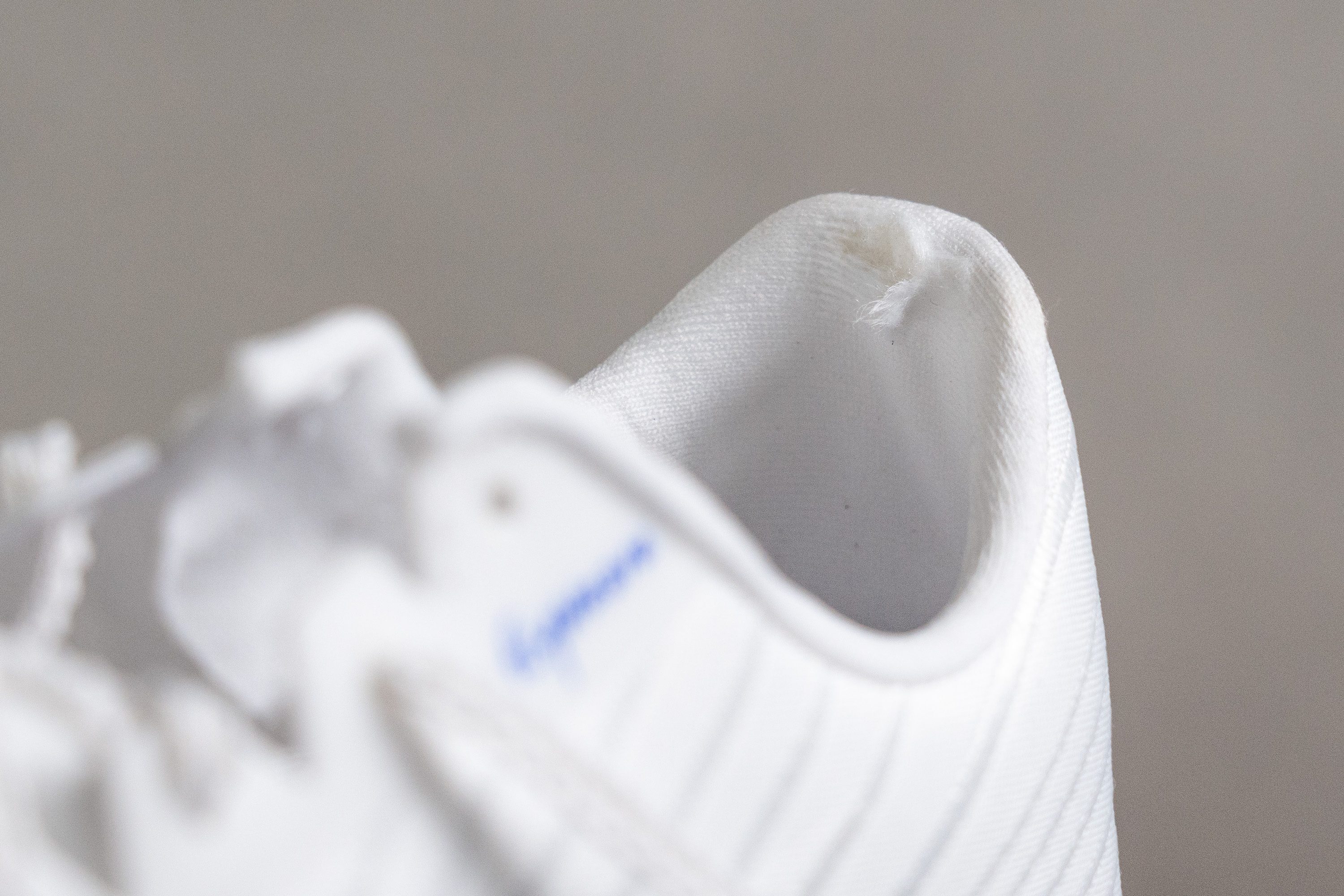
| Maxfly 2 | 2 |
| Average | 3.5 |
Outsole thickness
Our measurement revealed an outsole thickness of 1.9 mm, which should be enough.

We also noticed that Nike added dozens of ultra-tiny traction lugs to complement the pins, and it works wonders—the Maxfly 2 grips much better than the first version, which featured a different design.
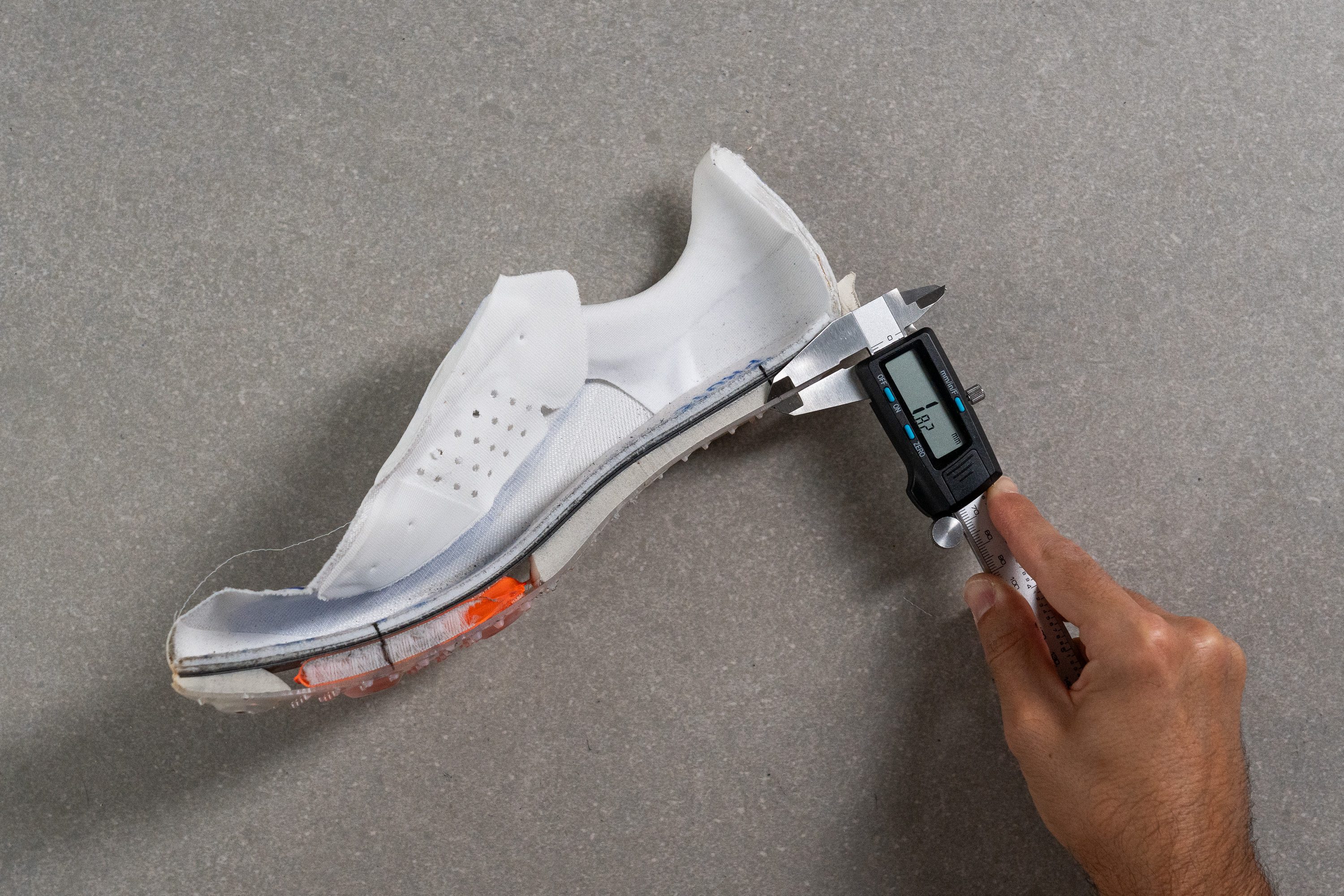
| Maxfly 2 | 1.8 mm |
| Average | 2.7 mm |
Pins
Nike has reduced the number of pins from the original Maxfly’s 7-pin setup to six. In our experience, this change has been positive—it went completely unnoticed in terms of traction thanks to the new outsole.
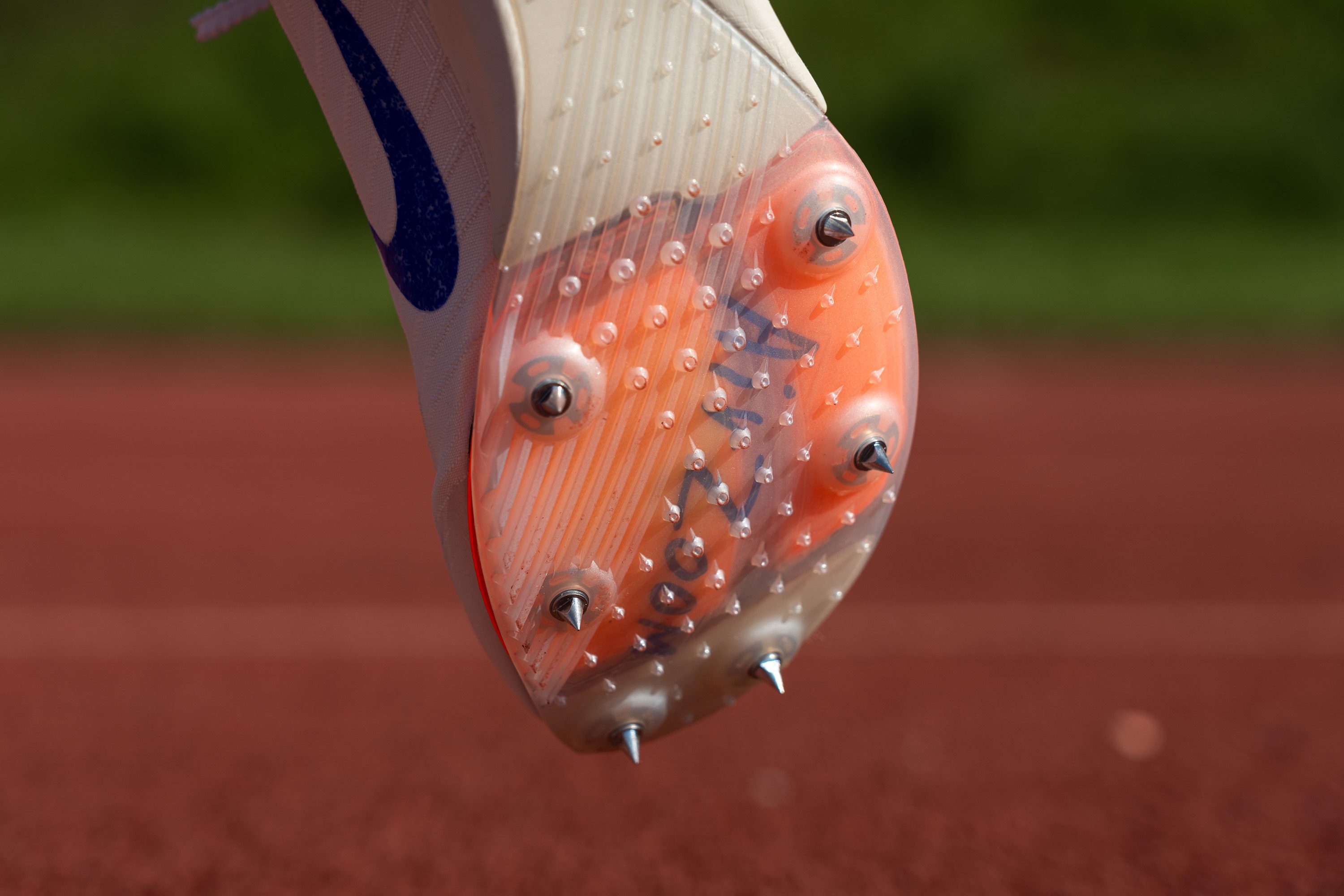
Misc
Insole thickness
The insole is more streamlined than what we typically find in road shoes, but it's exactly what we expect in a track spike—thinner at 3.3 mm, and also firmer to provide a more responsive feel.
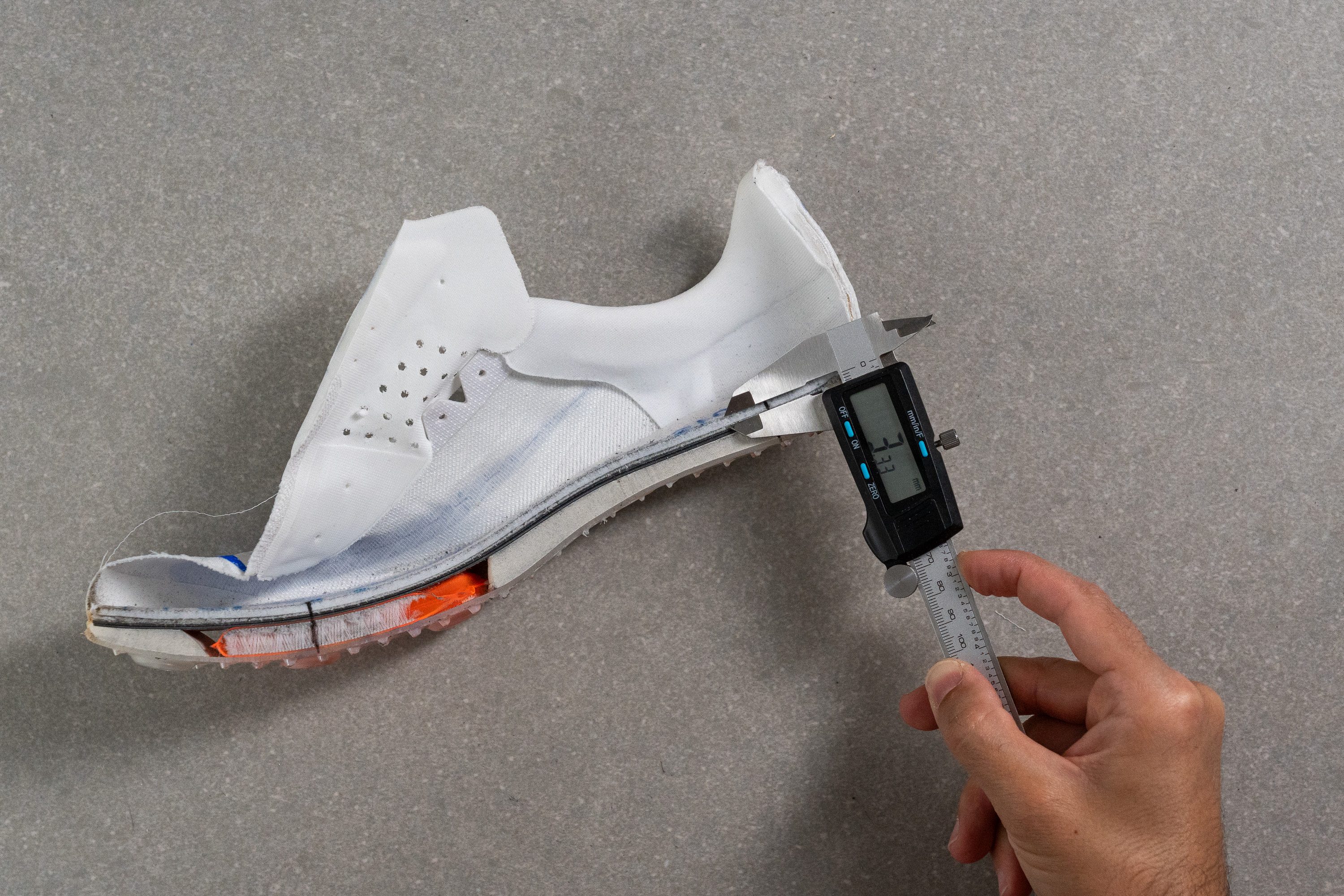
| Maxfly 2 | 3.3 mm |
| Average | 2.9 mm |
Tongue padding
When we reviewed the original Maxfly in the lab, we recommended trimming down the tongue padding, as the 3.9 mm thickness felt excessive for a performance spike. And Nike? Well, they didn’t quite listen.
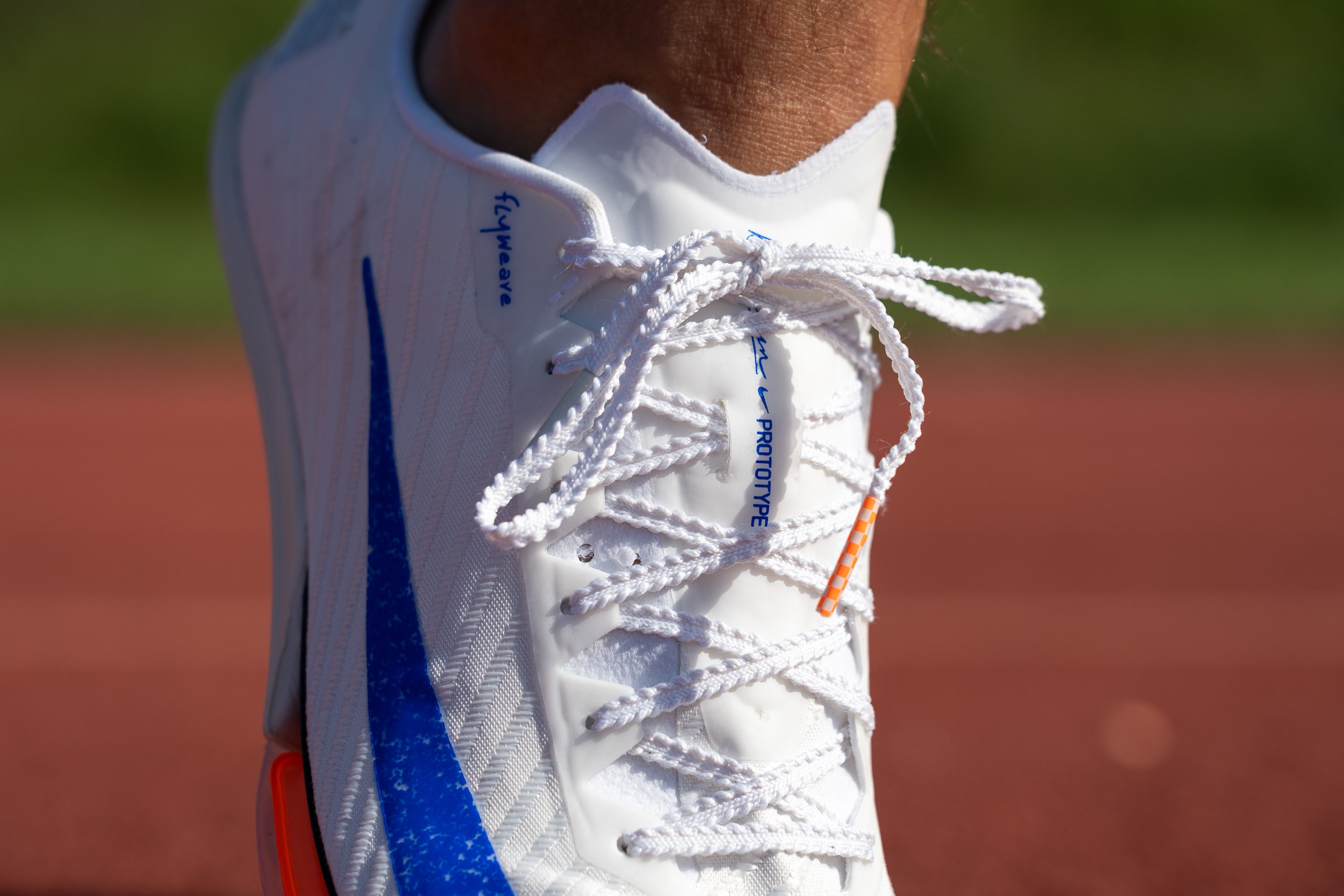
Instead, they increased the padding to a hefty 5.6 mm—surpassing not only Nike racing shoes, but even many daily trainers like the ASICS Novablast 4. While this offers top-tier protection for your instep and allows you to cinch the laces securely, we think it's simply too much.

| Maxfly 2 | 5.6 mm |
| Average | 2.4 mm |
Price
The Maxfly 2 was never designed to be an affordable track spike, and it certainly isn’t. It has all the premium features of a Nike shoe and it’s undeniably pricey. However, in our view, the steep cost is justified by the performance gains for those who are chasing times. But at the end of the day, it all depends on what your wallet can handle!
| Maxfly 2 | $190 |
| Average | $137 |
Heel tab
We found that Nike chose not to include a heel tab in the Maxfly 2, and we believe it’s a smart decision—it wouldn’t have made any sense. However, this would have been a great opportunity to introduce the iconic rear hole seen in other premium Nike spikes like the Dragonfly 2, saving a bit of weight in the process.
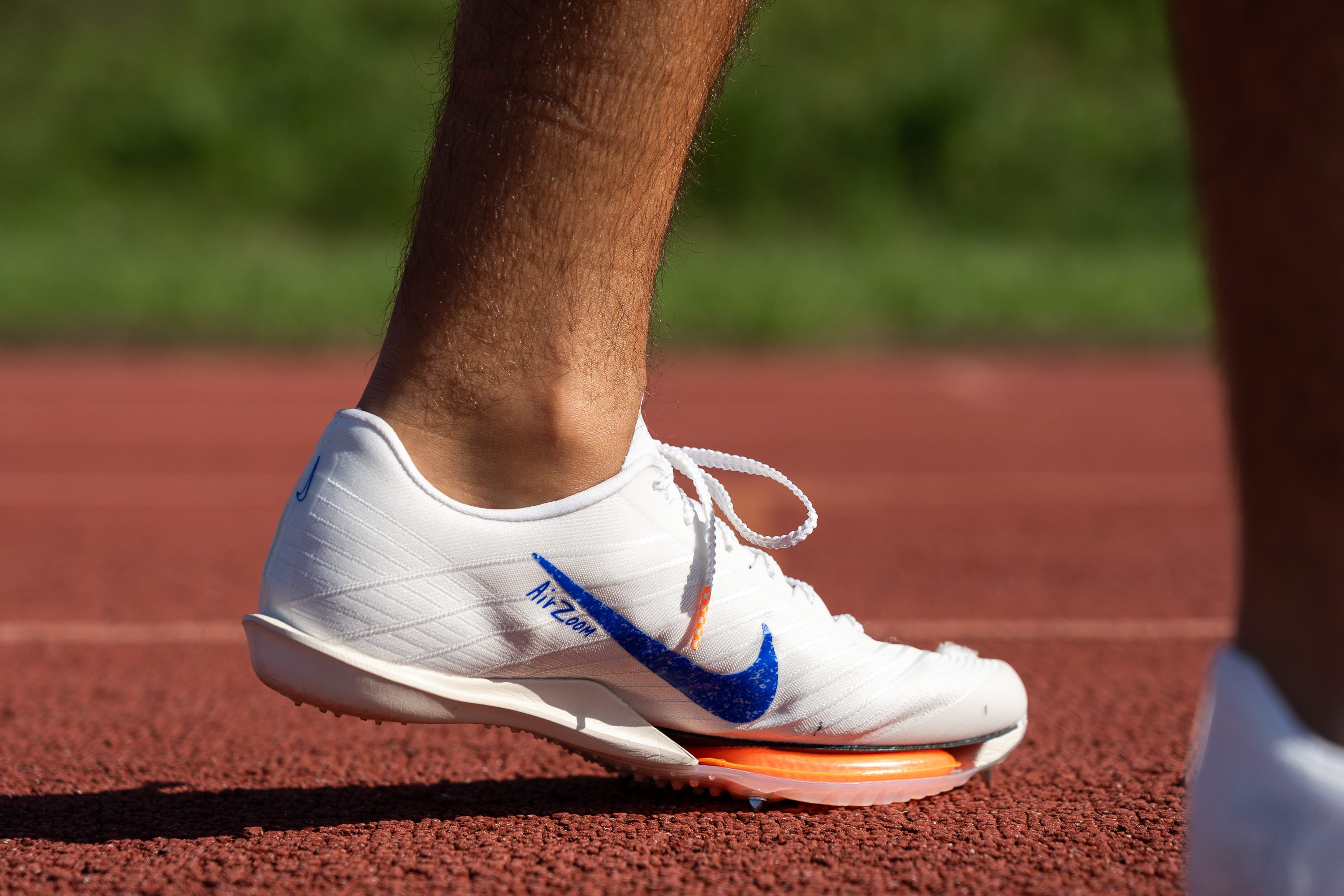
| Maxfly 2 | None |

